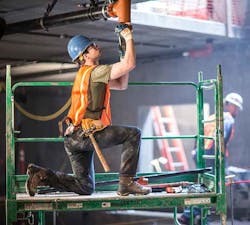This summer we published a tester’s review of KEEN Utility’s Mt. Vernon steel toe work boots ($200-210) and even gave a pair away. We were overwhelmed by all the positive feedback to the stories, and wanted to give our readers some insight into how KEEN Utility has created these tough-yet-comfortable work boots.
Mark Reilly, senior product line manager for KEEN Utility, says it starts with the last, the mechanical form that stands in for the human foot during the design process.
“We pride ourselves on having a unique fit that really separates us from the other brands,” Reilly says.
We asked him how the company actually gets that unique fit, and here are his answers.
NED: So why do you think people like the Mt. Vernon boots so much?
Reilly: Whether it’s our outdoor line, or our sandals, or Utility line, if you talk to KEEN fans, nine out of 10 keen fans will talk about the fit and how they’re the most comfortable shoes they’ve ever worn.
That’s because our owner/founder, Rory Fuerst, pays special attention and takes great care in trying to mimic the actual foot during the design process. Our last tends to be narrower in the heel which locks the foot in and helps to reduce friction of your heel sliding up and down in the boot, and more generous in the forefoot, following the foot’s natural shape. For the end user, it allows your foot to function as it would if you were barefoot.
Imagine as you’re walking and putting pressure on your fore foot, your toes naturally want to splay out under the weight of that walking motion. And that’s one thing our last accommodates really well: not confining your foot and making you feel crowded or cramped in the boot.
NED: Besides the fit, what else makes these so comfortable?
Reilly: We use a direct-inject soling process, which makes an unbelievable bond between the polyurethane midsole as and the upper.. Polyurethane (PU) doesn’t compact over time compared to other midsole materials. It’s a more durable material and the nice rebound you get on day one will still be there on day 1,000 or 2,000, or however long it is you wear the shoes.
Also, our steel toe fits the last. Most manufacturers go with off-the-shelf safety toes. In order to fit the steel toe, they shave the last down, which shrinks the amount of room inside the boot for your foot.
We took a completely different approach and built unique customized left and right steel toe. We partnered with steel toe manufacturer to makes them to our spec. Safety toes usually grade four different sizes. We added a fifth, so it stands to reason you get a better fit across the board.
NED: What are some of the safety features that make these fit for industrial environments?
Reilly: All the footwear in our KEEN Utility brand meet or exceed all the required safety standards. Additionally we incorporate a number of proprietary performance features like our KEEN.Dry waterproof membrane for waterproofing and moisture wicking lining material. That draws the moisture away from the foot, providing a healthier environment for the foot during an 8-10 hour workday.
NED: What does the product development process entail?
Reilly: It’s an 18-month development process. A briefing starts things, where we read documents that explain the need in marketplace and how to go about fulfilling that need with a piece of footwear.
Our team starts with two or three prototypes. We put them on a flex machine to make sure the flex points are in all the right places as well as a variety of other lab testing to ensure quality and performance.
During lab testing, we put the outsoles through slip testing, performing compression and impact tests on the safety toe, and test the membranes for waterproofing. They undergo 10,000 steps -- in water -- on flex machine. We make sure we exceed standards, and not ride ragged on the edge of succeeding.
NED: Our tester said these were some of the best shoes he’s ever worn. How do you achieve those results?
Reilly: We perform real world testing with individuals about 10 months in. We’ve got a battery of wear testers ranging from heavy machine operators to road crews to construction workers. They put two months of wear in a week.
These testers send back photos, every week to a month. It gives you a really good indication, because if it’s going to fail, it will fail early. You’ll know right away if it’s uncomfortable.

















